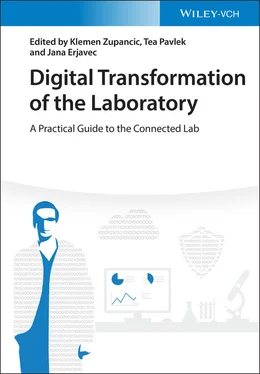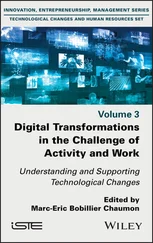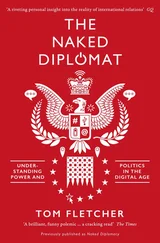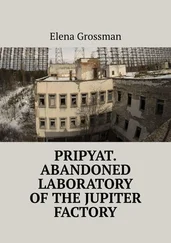69 69 Pistoia Alliance HELM Standard https://www.pistoiaalliance.org/helm-project/(accessed 1 February 2020).
70 70 Allotrope Foundation https://www.allotrope.org/solution(accessed 1 February 2020).
71 71 IMI Innovative Medicines Initiative https://www.imi.europa.eu/(accessed 1 February 2020).
72 72 Pistoia Alliance http://pistoiaalliance.org(accessed 1 February 2020).
73 73 Brooks, M. (2019). Beyond Quantum Supremacy. Nature 574 (7776): 19–21. Available from: https://doi.org/10.1038/d41586-019-02936-3.
74 74 Cao, Y., Romero, J., Olson, J.P. et al. (2019). Quantum chemistry in the age of quantum computing. Chemical Reviews 119 (19): 10856–10915. https://doi.org/10.1021/acs.chemrev.8b00803.
75 75 First image of Einstein's 'spooky' particle entanglement. https://www.bbc.co.uk/news/uk-scotland-glasgow-west-48971538(accessed 1 February 2020).
76 76 Al‐Khalili, J. BBC four Einsteins nightmare https://www.bbc.co.uk/programmes/b04tr9x9(Accessed 1 February 2020).
77 77 Quantum Riddle BBC four (2019). https://doi.org/10.1038/s41598-017-18364-0(accessed 1 February 2020).
78 78 Quantum computers flip the script on spin chemistry (2020). https://www.ibm.com/blogs/research/2020/02/quantum-spin-chemistry/(accessed 1 February 2020).
79 79 Kevin Hartnett. Quantum supremacy is coming: here's what you should know. https://www.quantamagazine.org/quantum-supremacy-is-coming-heres-what-you-should-know-20190718/(accessed 1 February 2020).
80 80 Chong, F., Franklin, D., and Martonosi, M. (2017). Programming languages and compiler design for realistic quantum hardware. Nature 549: 180–187. https://doi.org/10.1038/nature23459.
81 81 Edinburgh EPCC https://www.epcc.ed.ac.uk/facilities/archer(accessed 1 February 2020).
82 82 Argonne National Lab https://www.anl.gov/article/supercomputing-powerhouse(accessed 1 February 2020).
83 83 China Super Computing https://en.wikipedia.org/wiki/Supercomputing_in_China(accessed 1 February 2020).
84 84 Amazon is now offering quantum computing as a service (2019). https://www.theverge.com/2019/12/2/20992602/amazon-is-now-offering-quantum-computing-as-a-service(accessed 1 February 2020).
85 85 Schneider, P., Walters, W.P., Plowright, A.T. et al. (2019). Rethinking drug design in the artificial intelligence era. Nature Reviews. Drug Discovery 19: 353–364. https://doi.org/10.1038/s41573-019-0050-3.
86 86 Mak, K. and Pichika, M. (2019). Artificial intelligence in drug development: present status and future prospects. Drug Discovery Today 24 (3): 773–780. https://doi.org/10.1016/j.drudis.2018.11.014.
87 87 For a set of other potentially “hot” scientific areas as picked out in 2017. https://www.timeshighereducation.com/features/what-are-the-hot-research-areas-that-might-spark-the-next-big-bang(accessed 1 February 2020).
88 88 FDA https://www.fda.gov/consumers/consumer-updates/what-gene-therapy-how-does-it-work(accessed 1 February 2020).
89 89 National Cancer Institute https://www.cancer.gov/about-cancer/treatment/research/car-t-cells(accessed 1 February 2020).
90 90 Parida, S.K., Madansein, R., Singh, N. et al. (2015). Cellular therapy in tuberculosis. International Journal of Infectious Diseases 32: 32–38. https://doi.org/10.1016/j.ijid.2015.01.016.
91 91 Maldini, C.R., Ellis, G., and Riley, J.L. (2018). CAR‐T cells for infection, autoimmunity and allotransplantation. Nature Reviews. Immunology 18: 605–616. https://doi.org/10.1038/s41577-018-0042-2.
92 92 Stem cells: what they are and what they do. https://www.mayoclinic.org/tests-procedures/bone-marrow-transplant/in-depth/stem-cells/art-20048117(accessed 1 February 2020).
93 93 Bui, F., Almeida‐da‐Silva, C.L.C., Huynh, B. et al. (2019). Association between periodontal pathogens and systemic disease. Biomedical Journal 42 (1): 27–35. https://doi.org/10.1016/j.bj.2018.12.001.
94 94 Kakasis, A. and Panitsa, G. (2019). Bacteriophage therapy as an alternative treatment for human infections. A comprehensive review. International Journal of Antimicrobial Agents 53 (1): 16–21. https://doi.org/10.1016/j.ijantimicag.2018.09.004.
95 95 Lu, R., Hwang, Y.‐C., Liu, I.‐J. et al. (2020). Development of therapeutic antibodies for the treatment of diseases. Journal of Biomedical Science 27: 1. https://doi.org/10.1186/s12929-019-0592-z.
96 96 Bajan, S. and Hutvagner, G. (2020). RNA‐based therapeutics: from antisense oligonucleotides to miRNAs. Cells 9: 137. https://doi.org/10.3390/cells9010137.
97 97 Fosgerau, K. and Hoffmann, T. (2015). Peptide therapeutics: current status and future directions. Drug Discovery Today 20 (1): 122–128; https://doi.org/10.1016/j.drudis.2014.10.003.
98 98 Burslem, G.M. and Crews, C.M. (2020). Proteolysis‐targeting chimeras as therapeutics and tools for biological discovery. Cell 181: 1. https://doi.org/10.1016/j.cell.2019.11.031.
99 99 Ursell, L.K., Metcalf, J.L., Parfrey, L.W., and Knight, R. (2012). Defining the human microbiome. Nutrition Reviews 70 (Suppl 1): S38–S44. https://doi.org/10.1111/j.1753-4887.2012.00493.x.
100 100 Eloe‐Fadrosh, E.A. and Rasko, D.A. (2013). The human microbiome: from symbiosis to pathogenesis. Annual Review of Medicine 64: 145–163. https://doi.org/10.1146/annurev-med-010312-133513.
101 101 Russell, W.M.S. and Burch, R.L. (1959). The Principles of Humane Experimental Technique. London. ISBN 0900767782 [1]: Methuen.
102 102 (i) NC3Rs https://www.nc3rs.org.uk/. (ii) European Union: Directive 2010/63/EU. https://eur-lex.europa.eu/legal-content/EN/TXT/?uri=celex%3A32010L0063(accessed 1 February 2020).
103 103 Wenner Moyer, M. (2011). Organs‐on‐a‐chip for faster drug development. Scientific American. https://www.scientificamerican.com/article/organs-on-a-chip/(accessed 1 February 2020).
104 104 Voigtländer, B. (2015). Scanning Probe Microscopy. NanoScience and Technology. London, UK: Springer‐Verlag. https://doi.org/10.1007/978-3-662-45240-0.
105 105 Milne, J.L., Borgnia, M.J., Bartesaghi, A. et al. (2012). Cryo‐electron microscopy–a primer for the non‐microscopist. The FEBS Journal 280 (1): 28–45. https://doi.org/10.1111/febs.12078.
106 106 Gao, L., Zhao, H., Li, T. et al. (2018). Atomic force microscopy based tip‐enhanced Raman spectroscopy in biology. International Journal of Molecular Sciences 19: 1193. https://doi.org/10.3390/ijms19041193.
107 107 Debata, S., Das, T.R., Madhuri, R., and Sharma, P.K. (2018). Materials characterization using scanning tunneling microscopy: from fundamentals to advanced applications. In: Handbook of Materials Characterization (ed. S. Sharma), 217–261. Cham: Springer https://doi.org/10.1007/978-3-319-92955-2_6.
108 108 Michel, B. (1991). Highlights in condensed matter physics and future prospects. In: STM in Biology. NATO ASI Series (Series B: Physics), vol. 285 (ed. L. Esaki), 549–572. Boston, MA: Springer https://doi.org/10.1007/978-1-4899-3686-8_26.
109 109 Broadwith, P. (2017). Explainer: what is cryo‐electron microscopy? Chemistry World. https://www.chemistryworld.com/news/explainer-what-is-cryo-electron-microscopy/3008091.article(accessed 1 February 2020).
110 110 Aminu, M.D., Nabavi, S.A., Rochelle, C.A., and Manovic, V. (2017). A review of developments in carbon dioxide storage. Applied Energy 208: 1389–1419. https://doi.org/10.1016/j.apenergy.2017.09.015.
111 111 Heiska, J., Nisula, M., and Karppinen, M. (2019). Organic electrode materials with solid‐state battery technology. Journal of Materials Chemistry A 7: 18735–18758. https://doi.org/10.1039/C9TA04328D.
112 112 (i) Osuchowski, Marcin, F., Aletti, Federico, Cavaillon, Jean‐Marc, Flohé, Stefanie B., Giamarellos‐Bourboulis, Evangelos J., Huber‐Lang, Markus, Relja, Borna, Skirecki, Tomasz, Szabó, Andrea, and Maegele, Marc (2020). SARS‐CoV‐2/COVID‐19: evolving reality, global response, knowledge gaps, and opportunities. SHOCK 54 (4): 416–437. https://doi:10.1097/SHK.0000000000001565. (ii) https://search.bvsalud.org/global-literature-on-novel-coronavirus-2019-ncov/(accessed 16 November 2020). (iii) Lisheng, Wang, Yiru, Wang, Dawei, Ye, and Qingquan, Liu (2020). Review of the 2019 novel coronavirus (SARS‐CoV‐2) based on current evidence. International Journal of Antimicrobial Agents 55 (6): 105948. https://doi.org/10.1016/j.ijantimicag.2020.105948(accessed 16 November 2020).
Читать дальше











